SBAS-InSAR Based Deformation Detection of Urban Land, Created from Mega-Scale Mountain Excavating and Valley Filling in the Loess Plateau: The Case Study of Yan’an City
Abstract
:1. Introduction
2. Study Area
3. Materials and Methods
3.1. Sentinel-1A Data
3.2. SBAS-InSAR
3.2.1. Basic Theory of SBAS-InSAR
3.2.2. Data Processing
- The first part is the basis of the SBAS-InSAR. By selecting a definite temporal-spatial baseline threshold (time baseline 120 days, space baseline 121 m), the data sets were divided into different subsets and 201 interferometric pairs were generated (Figure 3).
- The second part is the interferometric flow step. Firstly, the external DEM data was utilized for auxiliary co-registration with accuracy of the sub-pixel level [48]. Then, the differential interferometry process was conducted for each pair to obtain interferograms and a coherence coefficient map. In addition, we removed the topographical phase by external DEM data, eliminated the noise phase using a Goldstein filter [49] and unwrapped the phase using the minimum cost flow (MCF) method [50]. Finally, Equation (6) was employed to calculate the theoretical precision with the interferometric coherence γ and the wavelength λ.
- The third part is the key step in generating surface deformation. In this research, ground control points (GCPs) were exploited to eliminate the change of phase caused by satellite orbit errors and remove the residual topographic phase. Once the quality inspection was approved, the linear model and residual phase were used to estimate the surface deformation. The effect of atmosphere delay was alleviated by a spatial-temporal filter (time filter window set to 365 days, space filter window set to 1800 m) to obtain the accumulated land deformation and average deformation rate along the LOS direction [51].
- The forth part is the process of generating land subsidence (vertical deformation). It is assumed that surface deformation mainly originated by vertical components while ignoring the influence of horizontal components. Vertical deformation S was calculated via combination with incident angle and displacement d in the LOS direction, based on the relationship shown as Equation (7) [52]. Finally, the surface displacement data were geocoded to obtain the result in the WGS84 coordinate system.
4. Results
4.1. Surface Deformation of YND
4.1.1. Spatial Distribution of the Land Subsidence
4.1.2. Temporal Evolution of the Land Subsidence
4.2. Surface Deformation of YNA
4.3. Validation of SBAS-InSAR Results
5. Discussion
5.1. Human Activities Contributing to the Land Subsidence
5.1.1. Large-Scale Land Creation
5.1.2. Rapid Urban Construction
5.2. Natural Factors Contributing to the Land Subsidence
6. Conclusions
- The SBAS-InSAR method and Sentinel-1A data achieved favorable results in the application of urban surface deformation monitoring in the Yan’an area, demonstrating the applicability of multi-temporal InSAR technology in the field of high-precision and large-scale land subsidence monitoring.
- Uneven surface deformation was observed in YND and YNA areas from 2015 to 2019. The average deformation rate and maximum cumulative subsidence in YND were between −70 and 30 mm/year and 300 mm, respectively. Moreover, the area experienced a rapid subsidence period from 2015 to 2017 and a slow subsidence period from 2017 to 2019, with maximum subsidence rates of 100 and 50 mm/year, respectively. The average rate of surface deformation in YNA is between −50 and 25 mm/year, and the maximum cumulative subsidence is 217 mm. The strong collapsibility of loess and concentrated precipitation in local areas are the main natural factors contributing to surface deformation.
- There was a high correlation between the deformation distribution and the earthwork. In other words, the land creation project carried out by mountain excavation and filling valleys and rapid urban construction are the primary human factors causing surface deformation.
Author Contributions
Funding
Acknowledgments
Conflicts of Interest
References
- Costantini, M.; Ferretti, A.; Minati, F.; Falco, S.; Trillo, F.; Colombo, D.; Novali, F.; Malvarosa, F.; Mammone, C.; Vecchioli, F.; et al. Analysis of surface deformations over the whole Italian territory by interferometric processing of ERS, Envisat and COSMO-SkyMed radar data. Remote Sens. Environ. 2017, 202, 250–275. [Google Scholar] [CrossRef]
- Chaussard, E.; Wdowinski, S.; Cabral-Cano, E.; Amelung, F. Land subsidence in central Mexico detected by ALOS InSAR time-series. Remote Sens. Environ. 2014, 140, 94–106. [Google Scholar] [CrossRef]
- Gu, C. Urbanization: Positive and negative effects. Sci. Bull. 2019, 64, 281–283. [Google Scholar] [CrossRef]
- Konagai, K.; Kiyota, T.; Suyama, S.; Asakura, T.; Shibuya, K.; Eto, C. Maps of soil subsidence for Tokyo bay shore areas liquefied in the March 11th, 2011 off the Pacific Coast of Tohoku Earthquake. Soil Dyn. Earthq. Eng. 2013, 53, 240–253. [Google Scholar] [CrossRef] [Green Version]
- Aimaiti, Y.; Yamazaki, F.; Liu, W. Multi-Sensor InSAR Analysis of Progressive Land Subsidence over the Coastal City of Urayasu, Japan. Remote Sens. 2018, 10, 1304. [Google Scholar] [CrossRef]
- Kooi, H. Land subsidence due to compaction in the coastal area of The Netherlands: The role of lateral fluid flow and constraints from well-log data. Glob. Planet. Chang. 2000, 27, 207–222. [Google Scholar] [CrossRef]
- Yao, G.; Ke, C.-Q.; Zhang, J.; Lu, Y.; Zhao, J.; Lee, H. Surface deformation monitoring of Shanghai based on ENVISAT ASAR and Sentinel-1A data. Environ. Earth Sci. 2019, 78, 225. [Google Scholar] [CrossRef]
- Chen, J.; Wu, J.; Zhang, L.; Zou, J.; Liu, G.; Zhang, R.; Yu, B. Deformation Trend Extraction Based on Multi-Temporal InSAR in Shanghai. Remote Sens. 2013, 5, 1774–1786. [Google Scholar] [CrossRef] [Green Version]
- Xu, B.; Feng, G.; Li, Z.; Wang, Q.; Wang, C.; Xie, R. Coastal Subsidence Monitoring Associated with Land Reclamation Using the Point Target Based SBAS-InSAR Method: A Case Study of Shenzhen, China. Remote Sens. 2016, 8, 652. [Google Scholar] [CrossRef]
- Ng, A.H.-M.; Ge, L.; Li, X.; Zhang, K. Monitoring ground deformation in Beijing, China with persistent scatterer SAR interferometry. J. Geod. 2012, 86, 375–392. [Google Scholar] [CrossRef]
- Bergado, D.T.; Nutalaya, P.; Balasubramaniam, A.S.; Apaipong, W.; Chang, C.-C.; Khaw, L.G. Causes, Effects, and Predictions of Land Subsidence in AIT Campus, Chao Phraya Plain, Bangkok, Thailand. Bull. Assoc. Eng. Geol. 1988, 25, 57–81. [Google Scholar] [CrossRef]
- Lazecky, M.; Jirankova, E.; Kadlecik, P. Subsidence. In Encyclopedia of Engineering Geology; Bobrowsky, P.T., Marker, B., Eds.; Springer: Cham, Switzerland, 2016; pp. 1–5. ISBN 978-3-31-12127-7. [Google Scholar]
- Cui, Z.-D. Physical Model Test of Layered Soil Subsidence Considering Dual Effects of Building Load and Groundwater Withdrawal. In Land Subsidence Induced by the Engineering-Environmental Effect; Cui, Z.-D., Ed.; Springer: Singapore, 2018; pp. 169–191. ISBN 978-981-10-8040-1. [Google Scholar]
- Milliman, J.D.; Haq, B.U. Sea-Level Rise and Coastal Subsidence: Towards Meaningful Strategies. In Sea-Level Rise and Coastal Subsidence: Causes, Consequences, and Strategies; Milliman, J.D., Haq, B.U., Eds.; Springer: Dordrecht, The Netherlands, 1996; pp. 1–9. ISBN 978-90-481-4672-7. [Google Scholar]
- Zeitoun, D.G.; Wakshal, E. The Subsidence Phenomenon Throughout the World. In Land Subsidence Analysis in Urban Areas: The Bangkok Metropolitan Area Case Study; Zeitoun, D.G., Wakshal, E., Eds.; Springer: Dordrecht, The Netherlands, 2013; pp. 9–23. ISBN 978-94-007-5506-2. [Google Scholar]
- Soriano, M.; Simón, J. Subsidence rates and urban damages in alluvial dolines of the Central Ebro basin (NE Spain). Environ. Geol. 2002, 42, 476–484. [Google Scholar] [CrossRef]
- Abidin, H.Z.; Andreas, H.; Gamal, M.; Djaja, R.; Subarya, C.; Hirose, K.; Maruyama, Y.; Murdohardono, D.; Rajiyowiryono, H. Monitoring Land Subsidence of Jakarta (Indonesia) Using Leveling, GPS Survey and InSAR Techniques. In A Window on the Future of Geodesy; Springer: Berlin/Heidelberg, Germany, 2005; pp. 561–566. [Google Scholar]
- Abidin, H.Z.; Andreas, H.; Gumilar, I.; Yuwono, B.D.; Murdohardono, D.; Supriyadi, S. On Integration of Geodetic Observation Results for Assessment of Land Subsidence Hazard Risk in Urban Areas of Indonesia. In IAG 150 Years; Springer: Cham, Switzerland, 2016; pp. 435–442. [Google Scholar]
- Hu, J.; Li, Z.W.; Ding, X.L.; Zhu, J.J.; Zhang, L.; Sun, Q. Resolving three-dimensional surface displacements from InSAR measurements: A review. Earth Sci. Rev. 2014, 133, 1–17. [Google Scholar] [CrossRef]
- Massonnet, D.; Rossi, M.; Carmona, C.; Adragna, F.; Peltzer, G.; Feigl, K.; Rabaute, T. The displacement field of the Landers earthquake mapped by radar interferometry. Nature 1993, 364, 138–142. [Google Scholar] [CrossRef]
- Milillo, P.; Minchew, B.; Simons, M.; Agram, P.; Riel, B. Geodetic Imaging of Time-Dependent Three-Component Surface Deformation: Application to Tidal-Timescale Ice Flow of Rutford Ice Stream, West Antarctica. IEEE Trans. Geosci. Remote Sens. 2017, 55, 5515–5524. [Google Scholar] [CrossRef]
- Milillo, P.; Giardina, G.; DeJong, J.M.; Perissin, D.; Milillo, G. Multi-Temporal InSAR Structural Damage Assessment: The London Crossrail Case Study. Remote Sens. 2018, 10, 287. [Google Scholar] [CrossRef]
- Ferretti, A.; Prati, C.; Rocca, F. Nonlinear subsidence rate estimation using permanent scatterers in differential SAR interferometry. IEEE Trans. Geosci. Remote Sens. 2000, 38, 2202–2212. [Google Scholar] [CrossRef] [Green Version]
- Ferretti, A.; Prati, C.; Rocca, F. Permanent scatterers in SAR interferometry. IEEE Trans. Geosci. Remote Sens. 2001, 39, 8–20. [Google Scholar] [CrossRef]
- Berardino, P.; Fornaro, G.; Lanari, R.; Sansosti, E. A new algorithm for surface deformation monitoring based on small baseline differential SAR interferograms. IEEE Trans. Geosci. Remote Sens. 2002, 40, 2375–2383. [Google Scholar] [CrossRef] [Green Version]
- Zhang, Y.; Liu, Y.; Jin, M.; Jing, Y.; Liu, Y.; Liu, Y.; Sun, W.; Wei, J.; Chen, Y. Monitoring Land Subsidence in Wuhan City (China) using the SBAS-InSAR Method with Radarsat-2 Imagery Data. Sensors 2019, 19, 743. [Google Scholar] [CrossRef]
- Zhou, L.; Guo, J.; Hu, J.; Li, J.; Xu, Y.; Pan, Y.; Shi, M. Wuhan Surface Subsidence Analysis in 2015–2016 Based on Sentinel-1A Data by SBAS-InSAR. Remote Sens. 2017, 9, 982. [Google Scholar] [CrossRef]
- Chaussard, E.; Amelung, F.; Abidin, H.; Hong, S.-H. Sinking cities in Indonesia: ALOS PALSAR detects rapid subsidence due to groundwater and gas extraction. Remote Sens. Environ. 2013, 128, 150–161. [Google Scholar] [CrossRef]
- Zhu, J.; Li, Z.; Hu, J. Research Progress and Methods of InSAR for Deformation Monitoring. Acta Geod. Cartogr. Sin. 2017, 46, 1717–1733. [Google Scholar] [CrossRef]
- Tizzani, P.; Berardino, P.; Casu, F.; Euillades, P.; Manzo, M.; Ricciardi, G.P.; Zeni, G.; Lanari, R. Surface deformation of Long Valley caldera and Mono Basin, California, investigated with the SBAS-InSAR approach. Remote Sens. Environ. 2007, 108, 277–289. [Google Scholar] [CrossRef]
- Casu, F.; Manzo, M.; Lanari, R. A quantitative assessment of the SBAS algorithm performance for surface deformation retrieval from DInSAR data. Remote Sens. Environ. 2006, 102, 195–210. [Google Scholar] [CrossRef]
- Xue, Y.-Q.; Zhang, Y.; Ye, S.-J.; Wu, J.-C.; Li, Q.-F. Land subsidence in China. Environ. Geol. 2005, 48, 713–720. [Google Scholar] [CrossRef]
- Zhang, B.; Wang, R.; Deng, Y.; Ma, P.; Lin, H.; Wang, J. Mapping the Yellow River Delta land subsidence with multitemporal SAR interferometry by exploiting both persistent and distributed scatterers. ISPRS J. Photogramm. Remote Sens. 2019, 148, 157–173. [Google Scholar] [CrossRef]
- Holzer, T.L.; Johnson, A.I. Land subsidence caused by ground water withdrawal in urban areas. GeoJournal 1985, 11, 245–255. [Google Scholar] [CrossRef]
- Wang, S.; Fu, B.; Chen, H.; Liu, Y. Regional development boundary of China’s Loess Plateau: Water limit and land shortage. Land Use Policy 2018, 74, 130–136. [Google Scholar] [CrossRef]
- Liu, Y.; Li, Y. Environment: China’s land creation project stands firm. Nature 2014, 511, 410. [Google Scholar] [CrossRef]
- Li, P.; Qian, H.; Wu, J. Environment: Accelerate research on land creation. Nature 2014, 510, 29–31. [Google Scholar] [CrossRef] [PubMed]
- Juang, C.H.; Dijkstra, T.; Wasowski, J.; Meng, X. Loess geohazards research in China: Advances and challenges for mega engineering projects. Eng. Geol. 2019, 251, 1–10. [Google Scholar] [CrossRef]
- Chen, G.; Zhang, Y.; Zeng, R.; Yang, Z.; Chen, X.; Zhao, F.; Meng, X. Detection of Land Subsidence Associated with Land Creation and Rapid Urbanization in the Chinese Loess Plateau Using Time Series InSAR: A Case Study of Lanzhou New District. Remote Sens. 2018, 10, 270. [Google Scholar] [CrossRef]
- China Today. Available online: http://www.chinatoday.com/city/yanan.htm (accessed on 5 June 2019).
- Li, X.-A.; Li, L.; Song, Y.; Hong, B.; Wang, L.; Sun, J. Characterization of the mechanisms underlying loess collapsibility for land-creation project in Shaanxi Province, China—A study from a micro perspective. Eng. Geol. 2019, 249, 77–88. [Google Scholar] [CrossRef]
- Zhang, Y. Study on the Formation Mechanism of Loess Collapse Induced by Rainfall in Yan’an Area. Master’s Thesis, Xi’an University of Science and Technology, Xi’an, China, 2016. [Google Scholar]
- Zhou, J.; Fu, B.; Gao, G.; Lü, Y.; Liu, Y.; Lü, N.; Wang, S. Effects of precipitation and restoration vegetation on soil erosion in a semi-arid environment in the Loess Plateau, China. Catena 2016, 137, 1–11. [Google Scholar] [CrossRef]
- Wang, G.; Li, T.; Xing, X.; Zou, Y. Research on loess flow-slides induced by rainfall in July 2013 in Yan’an, NW China. Environ. Earth Sci. 2015, 73, 7933–7944. [Google Scholar] [CrossRef]
- Guorui, G. Formation and development of the structure of collapsing loess in China. Eng. Geol. 1988, 25, 235–245. [Google Scholar] [CrossRef]
- The Government Website of Shaanxi Province. Available online: http://www.shaanxi.gov.cn/sxxw/sxyw/125967.htm (accessed on 9 November 2018).
- Mora, O.; Mallorqui, J.J.; Broquetas, A. Linear and nonlinear terrain deformation maps from a reduced set of interferometric SAR images. IEEE Trans. Geosci. Remote Sens. 2003, 41, 2243–2253. [Google Scholar] [CrossRef]
- Sansosti, E.; Berardino, P.; Manunta, M.; Serafino, F.; Fornaro, G. Geometrical SAR image registration. IEEE Trans. Geosci. Remote Sens. 2006, 44, 2861–2870. [Google Scholar] [CrossRef]
- Goldstein, R.M.; Werner, C.L. Radar interferogram filtering for geophysical applications. Geophys. Res. Lett. 1998, 25, 4035–4038. [Google Scholar] [CrossRef] [Green Version]
- Costantini, M. A novel phase unwrapping method based on network programming. IEEE Trans. Geosci. Remote Sens. 1998, 36, 813–821. [Google Scholar] [CrossRef]
- Pepe, A.; Berardino, P.; Bonano, M.; Euillades, L.D.; Lanari, R.; Sansosti, E. SBAS-Based Satellite Orbit Correction for the Generation of DInSAR Time-Series: Application to RADARSAT-1 Data. IEEE Trans. Geosci. Remote Sens. 2011, 49, 5150–5165. [Google Scholar] [CrossRef]
- Yastika, P.E.; Shimizu, N.; Abidin, H.Z. Monitoring of long-term land subsidence from 2003 to 2017 in coastal area of Semarang, Indonesia by SBAS DInSAR analyses using Envisat-ASAR, ALOS-PALSAR, and Sentinel-1A SAR data. Adv. Space Res. 2019, 63, 1719–1736. [Google Scholar] [CrossRef]
- Jiang, M.; Zhang, F.; Hu, H.; Cui, Y.; Peng, J. Structural characterization of natural loess and remolded loess under triaxial tests. Eng. Geol. 2014, 181, 249–260. [Google Scholar] [CrossRef]
- Li, P.; Vanapalli, S.; Li, T. Review of collapse triggering mechanism of collapsible soils due to wetting. J. Rock Mech. Geotech. Eng. 2016, 8, 256–274. [Google Scholar] [CrossRef]
- Wang, F. Experimental Study on Deformation Characteristics of Structural Loess under High Stress in Yan’an Area. Master’s Thesis, Xi’an University of Science and Technology, Xi’an, China, 2018. [Google Scholar]
- Gao, D. Research on Characteristics of Deformation and Strength as well as Moisture Retention of Loess in Yan’an New Area. Master’s Thesis, Lanzhou University of Technology, Lanzhou, China, 2016. [Google Scholar]







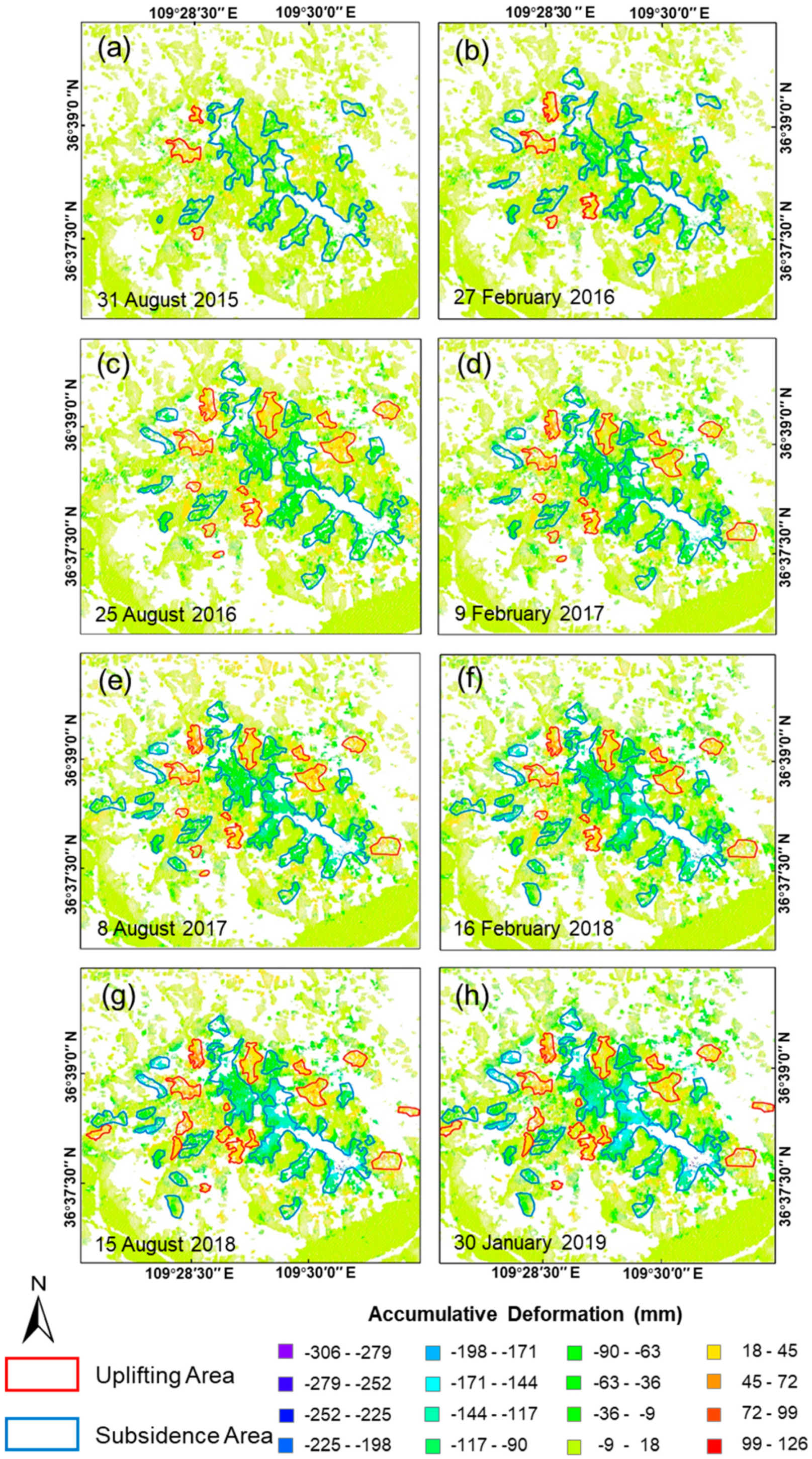
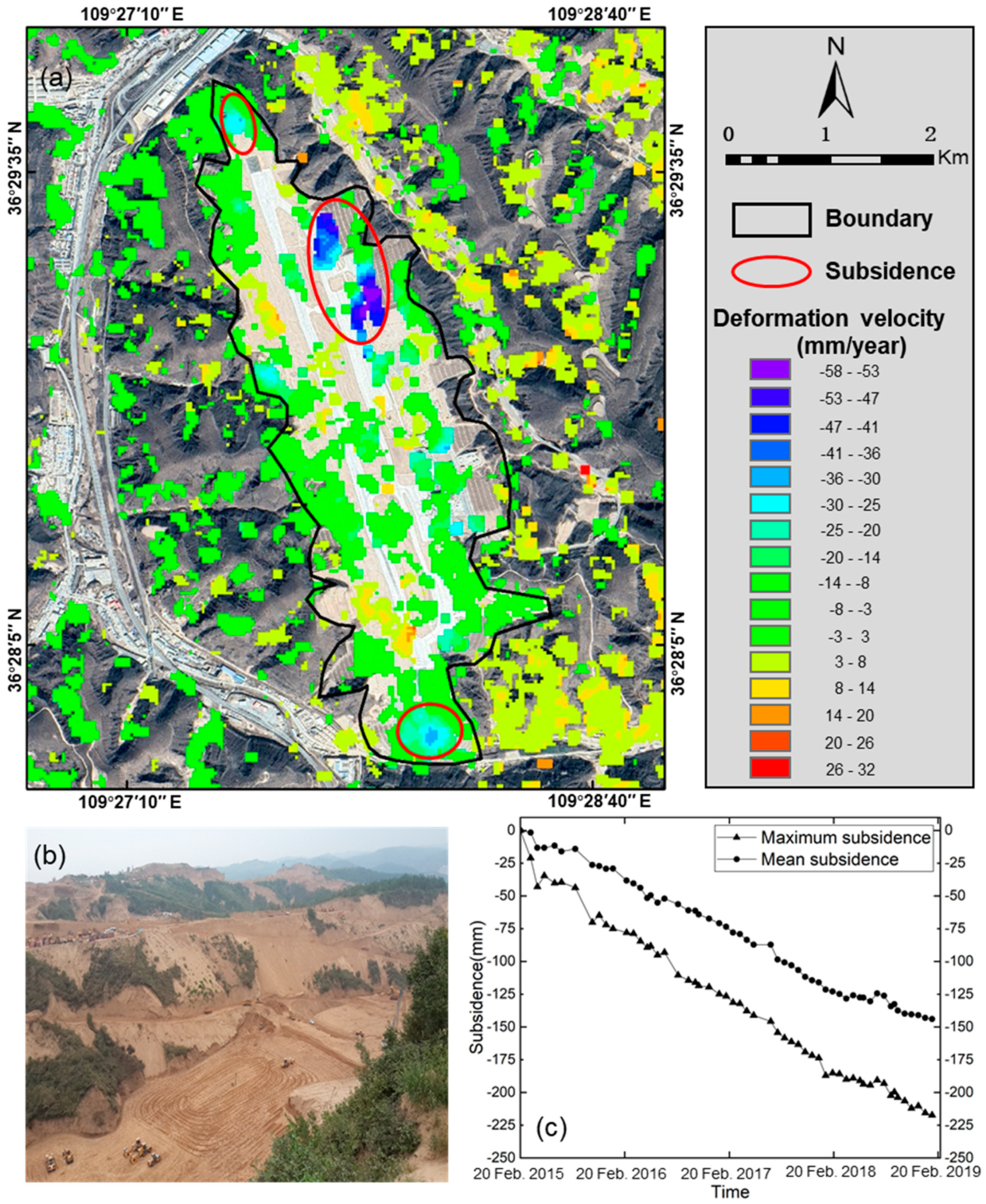


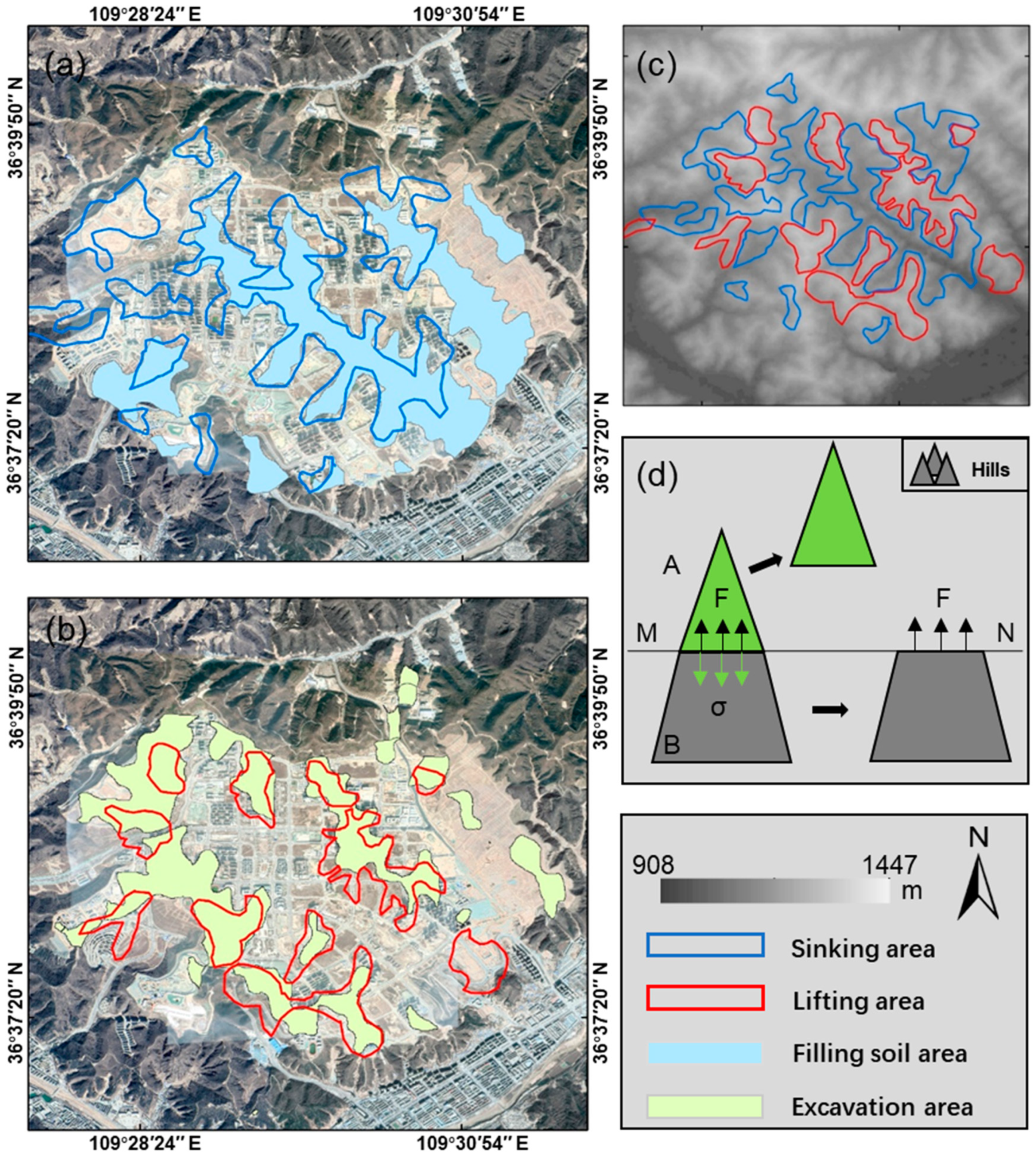
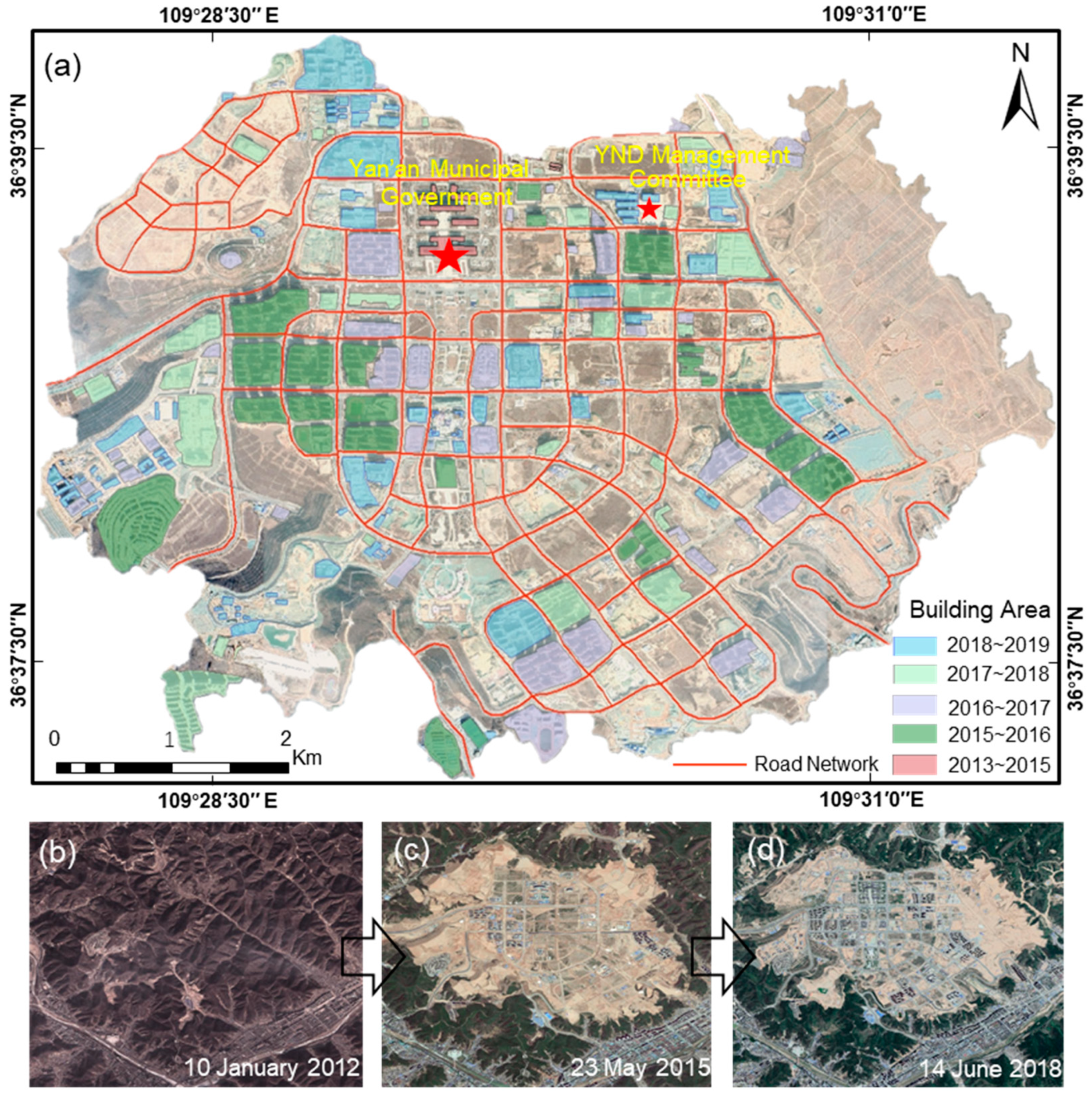
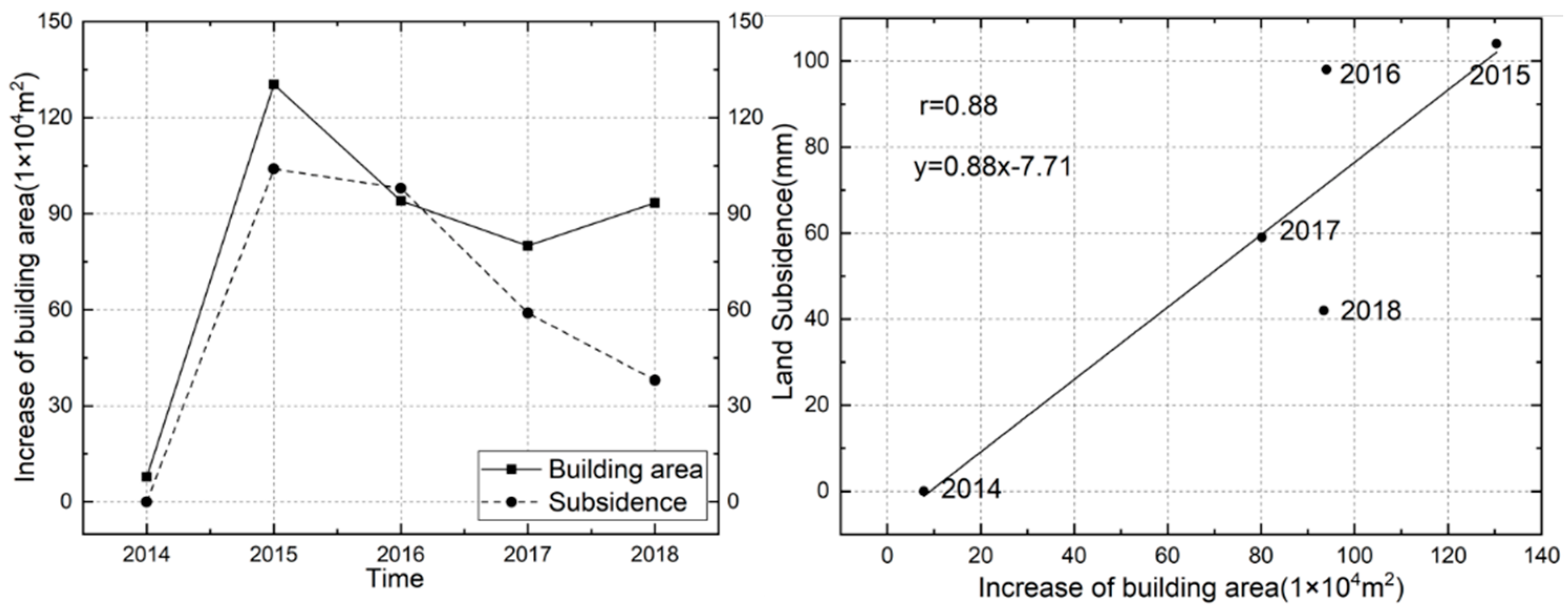
| Data | Parameters | Description |
|---|---|---|
| Sentinel-1A | Type | SLC |
| Imaging mode | IW | |
| Band and wavelength (cm) | C, 5.5 | |
| Track number | 84 | |
| Orbit direction | Ascending | |
| Azimuth resolution (m) | 20 | |
| Range resolution (m) | 5 | |
| Polarization | VV | |
| SRTM | Resolution (m) | 30 |
| Positioning accuracy (m) | 20 | |
| Elevation accuracy (m) | 16 |
© 2019 by the authors. Licensee MDPI, Basel, Switzerland. This article is an open access article distributed under the terms and conditions of the Creative Commons Attribution (CC BY) license (http://creativecommons.org/licenses/by/4.0/).
Share and Cite
Wu, Q.; Jia, C.; Chen, S.; Li, H. SBAS-InSAR Based Deformation Detection of Urban Land, Created from Mega-Scale Mountain Excavating and Valley Filling in the Loess Plateau: The Case Study of Yan’an City. Remote Sens. 2019, 11, 1673. https://doi.org/10.3390/rs11141673
Wu Q, Jia C, Chen S, Li H. SBAS-InSAR Based Deformation Detection of Urban Land, Created from Mega-Scale Mountain Excavating and Valley Filling in the Loess Plateau: The Case Study of Yan’an City. Remote Sensing. 2019; 11(14):1673. https://doi.org/10.3390/rs11141673
Chicago/Turabian StyleWu, Qiong, Chunting Jia, Shengbo Chen, and Hongqing Li. 2019. "SBAS-InSAR Based Deformation Detection of Urban Land, Created from Mega-Scale Mountain Excavating and Valley Filling in the Loess Plateau: The Case Study of Yan’an City" Remote Sensing 11, no. 14: 1673. https://doi.org/10.3390/rs11141673





